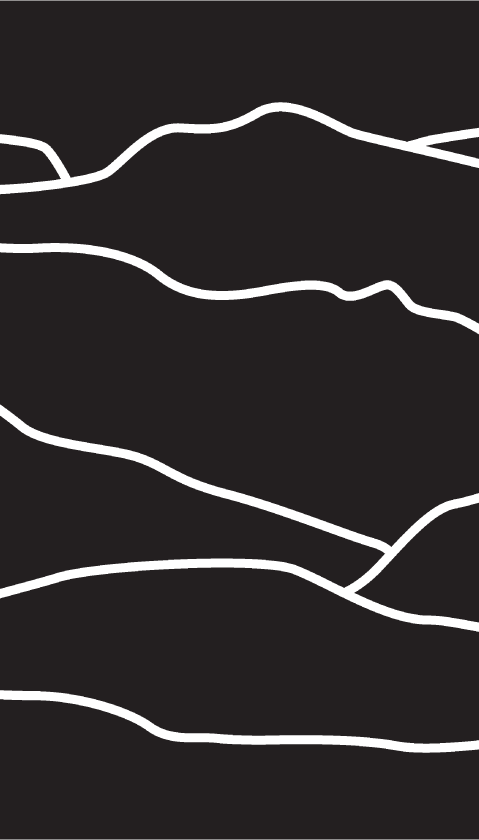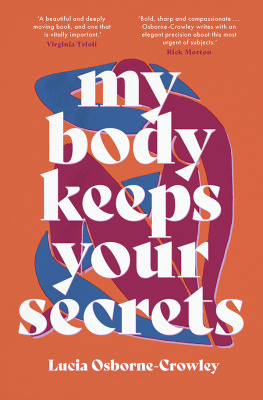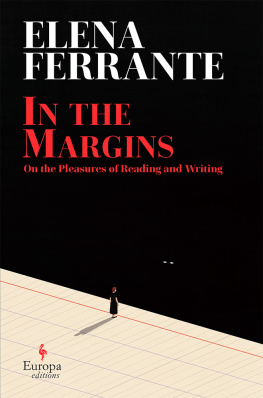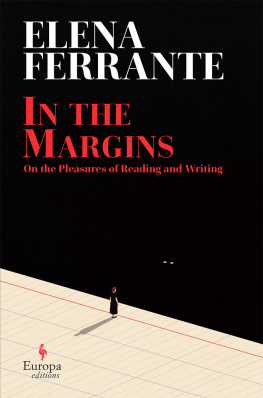Contents
Guide


I CHOOSE
ELENA
ON TRAUMA, MEMORY
AND SURVIVAL

THE MOOD INDIGO
ESSAY SERIES
I CHOOSE
ELENA
ON TRAUMA, MEMORY
AND SURVIVAL
LUCIA OSBORNE-CROWLEY

MOOD INDIGO
An imprint of The Indigo Press
50 Albemarle Street
London W1S 4BD
www.theindigopress.com
The Indigo Press Limited Reg. No. 10995574
Registered Office: Wellesley House, Duke of Wellington Avenue
Royal Arsenal, London SE18 6SS
COPYRIGHT LUCIA OSBORNE-CROWLEY 2019
Lucia Osborne-Crowley asserts the moral right to be identified as the author of this work in accordance with the Copyright, Designs and Patents Act 1988
First published in Great Britain in 2019 by The Indigo Press
A CIP catalogue record for this book is available from the British Library
eBook ISBN 978-1-911648-00-0
ISBN 978-1-9996833-9-9
All rights reserved. No part of this publication may be reproduced, stored in a retrieval system or transmitted, in any form or by any means, electronic, mechanical, photocopying, recording or otherwise, without the prior permission of the publishers
Design by www.salu.io
Typeset in Goudy Old Style by www.beyondwhitespace.com
E-book produced by
Geethik Technologies Pvt Ltd
Tamil Nadu, India
To Elena, who taught me to love without suffering
CONTENTS
In order to rise
From its own ashes,
A phoenix
First
Must
Burn.
Octavia E. Butler
I
I buried the girl I had been because she ran into all kinds of trouble. I tried to erase every memory of her. But she is still there, somewhere.
Roxane Gay, Hunger: A Memoir of (My) Body
BEGINNINGS
G rowing up, I was a gymnast. The serious kind. By the time I was ten, I had represented New South Wales at the national championships and won. At age twelve, I represented Australia at the world championships.
By fifteen, I was preparing for my second world championships. I trained relentlessly.
Every morning I drank raw eggs mixed with protein powder and milk. I was training so much that my body had started using my muscle mass for energy, which could result in my muscles atrophying. Thats what the raw eggs were for: I needed to be consuming as much protein as possible to keep my muscles intact.
Weakness was the one thing we were all taught to avoid. I took this lesson seriously. No amount of eggs, protein bars, crunches, toe-points, handstand push-ups or weightlifts could deter me. I would push my body right to its limits, then further.
The kind of gymnastics I was doing required immense mental precision. I needed to synchronize wholly with my body, to pick up on every signal it sent me. I needed to master a very particular kind of mindfulness in order to step onto a velvet floor on a world stage, with five international judges ready to pick apart my every movement. My mind had to be so still that it could communicate with every pointed toe, every carefully balanced leg, every finger.
I had to be perfect, and it had to seem effortless. I had to be strong and powerful and graceful and light, all at the same time. I had to smile. To do all these things at once takes a kind of mindbody alignment that I have been dreaming of regaining ever since I stepped off the floor for the last time. My body and my mind, it seemed then, belonged wholly to me.
I was obsessed with this feeling. When I wasnt training, I took ballet classes to fill the time.
We called the gym our second home. For some of us, at times, it felt like a first home. Each year when we qualified for the national team, we would go on week-long training camps during which we would wake up at 5 a.m. to go for a long run, then do three training sessions throughout the day before crawling into sleeping bags placed atop crash mats on the gym floor. When we were slow to wake up, my coach would play Rihannas Pon de Replay on the gymnasiums enormous sound system.
I would be thrown in the air by another gymnast and do a double somersault and land perfectly. Sometimes the somersaults would be in the pike position, or the layout position, so you had to jump high and hard enough to rotate your stretched-out body twice before reaching the floor. Sometimes we did triple somersaults. Sometimes we did double layouts with a full twist in the first rotation.
We balanced our handstands on the hands of another gymnast and then morphed our bodies into overarch a move in which you arch your back so much in the handstand that your feet touch your hands while the gymnast holding us up slides into the splits. Sometimes we did the handstands with only one arm.
These manoeuvres are not just complicated but profoundly dangerous gymnasts have died or been rendered paraplegic by a missed landing. We were all okay with danger; we were fearless. But the thing about staying safe as an athlete at that level is that your technique must be perfect. You need to know exactly how to jump; where your arms need to be at each point in a double somersault; how to hold your legs, your chest and your fingers so your handstand is unshakable.
I knew every inch of my body so well, could feel every tiny sensation, could always tell if something was even just a little bit off.
Once I messed up a skill during training and I told my coach I hadnt slept well the night before; that I was nervous about a speech I had to give at school. His response was: If you are the athlete I know you can be, I should be able to wake you up in the middle of the night and you should be able to perform your skills, half asleep, with no warning.
Im not sure if this was intended to be a metaphor; one he was using to teach me that at this level of the game, there is no excuse for mistakes. But I took it literally: I started waking myself up in the middle of the night and making sure I could hold a free handstand for three minutes straight.
The only time we got a day off was when a big competition was approaching. They call this tapering: a way of giving the body and the muscles a chance to recover from weeks and months of intense training so that all are in peak form for competition day. Sometimes these days were the hardest of them all; without training the thing we spent the majority of our time doing we had all these leftover hours to spend getting nervous about the competition.
During these tapering days, we were told to focus on mental preparation. We were taught by sports psychologists from the age of nine or ten how best to use the mental technique of visualization: a process in which we sit still, close our eyes and imagine ourselves really imagine, including the sounds and smells and stomach flips performing our routines.
During visualization, we would focus on the tricks or parts of the routine that frightened us the most, and we would make sure that we performed those elements flawlessly.


















